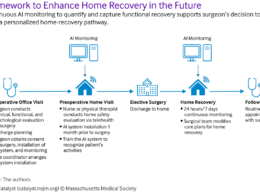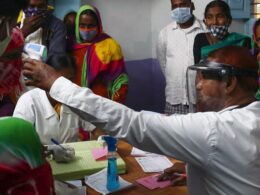Kelly Bliss teased upcoming clients for a new virtual-first primary care product and parsed out Teladoc’s growth strategies for 2022 and beyond.
Health Care Dive
Rebecca Pifer
Oct. 27, 2021
Care models combining physical and digital elements have become increasingly commonplace in the U.S. after more than a year and a half of the pandemic progressively normalizing virtual care, especially in the chronically underfunded primary care sector.
Proponents of such hybrid methods tout how they can expand access to primary care, hopefully preventing health complications and higher costs down the line by increasing prevention and screening.
Virtual care vendor Teladoc was one of the first telehealth providers to pilot a virtual-first primary care offering a few years ago, a program that the New York-based company expanded nationwide earlier this month following client demand.
The program, called Primary360 or “P360” internally, is an evidence-based longitudinal care plan and an opportunity for employers to nudge some of their populations that wouldn’t normally use primary care to the service by leveraging a virtual front door, Kelly Bliss, president of U.S. Group Health, told Healthcare Dive.
The program, called Primary360 or “P360” internally, is an evidence-based longitudinal care plan and an opportunity for employers to nudge some of their populations that wouldn’t normally use primary care to the service by leveraging a virtual front door…
Primary360 already has several large employer and health plan clients, including CVS Health-owned Aetna, and plans to announce more launches over the course of the next few months, Bliss, who came to Teladoc in 2017 with the acquisition of expert medical opinion company Best Doctors, said.
Primary360 already has several large employer and health plan clients, including CVS Health-owned Aetna, and plans to announce more launches over the course of the next few months,

In an interview, Bliss teased the traction Teladoc’s seeing in primary care, how devices tie into that strategy, and how employers and payers alike are driving digital adoption and hyper-growth areas the company sees in 2022 and beyond.
“Over the next six years, we expect virtual to not actually be in our vernacular anymore. It’s going to be care, and more convenient care,” Bliss said. “It’s all just green space for us.”
…Teladoc’s is seeing a traction in primary care, how devices tie into that strategy, and how employers and payers alike are driving digital adoption and hyper-growth areas the company sees in 2022 and beyond.
- Employers and health plans alike driving the digital shift
- Teladoc trying to push its whole-person view as key market differentiator, as primary care offering drives huge client interest
- Devices, Livongo play big role in facilitating at-home primary care
- 3 hyper-growth areas for 2022

1.Employers and health plans alike driving the digital shift
Rising consumerism has been increasing the healthcare industry’s focus on convenience and accessibility.
That momentum is driving a sea change in what types of care employers and payers look to purchase as many turn to digital tools to better access.
Teladoc says it’s in a position to capitalize on that shift after years of building out its technological infrastructure and clinical use cases.
Bliss said one of the more fascinating trends she’s noticed during COVID-19 has been a shift in where innovation normally comes from in the payments industry.
Typically, employers look for solutions for the specific health needs of their employee base, and then eventually health plans start to cover such services, meaning early adopters of new digital offerings are usually employers before benefits consultants start to pick them up and drive greater adoption.
But “one of the things that we’re seeing that’s really sort of unique, especially around products like Primary360 that we’ve launched last year, is we’re in market now and both markets are driving very quickly, concurrently,” Bliss said.
That inflection point was coming even before the coronavirus, according to the executive, but COVID-19 accelerated employers’ shift away from buying point solutions toward more holistic benefits offered by larger vendors.
“COVID certainly created this new awareness in use cases and the value of really a whole-person view in virtual,” Bliss said. “So one of the unique plays in the health plan space is obviously virtual care of any kind. It’s to dovetail and really work with the brick-and-mortar care locations — we’ve really built our P360 program really around bringing to bear on health plan partner strategies, leveraging their networks through our clinical use cases through our front door … I think that’s sort of why the adoption curve has been sort of a concurrent adoption curve.”
2.Teladoc trying to push its whole-person view as key market differentiator, as primary care offering drives huge client interest
The pipeline for Primary360 continues to grow, and Teladoc plans to make more announcements as new health plans and employers come on, according to Bliss.
It’s an increasingly competitive space as telehealth vendors, health plans and employers alike look to digitize primary care.
Diversified healthcare behemoth UnitedHealth, e-commerce giant Amazon and health insurer Cigna have all recently announced plans to launch or expand their virtual-first primary care services.
Diversified healthcare behemoth UnitedHealth, e-commerce giant Amazon and health insurer Cigna have all recently announced plans to launch or expand their virtual-first primary care services.
But Teladoc plans to continue pushing into what the executive termed the “interstitial space” in the overlap between primary, specialty, chronic, behavioral and wellness care, not just digitizing the old model of primary care — for example, every new cancer diagnosis should have an immediate mental health referral, Bliss said.
Teladoc hopes having all these use cases on a single platform will serve as a major differentiator from its peers.
… Teladoc plans to continue pushing into what the executive termed the “interstitial space” in the overlap between primary, specialty, chronic, behavioral and wellness care, not just digitizing the old model of primary care
Teladoc hopes having all these use cases on a single platform will serve as a major differentiator from its peers.
“What we’re building is a whole-person view, and it’s less about what I think a lot of the products that are on the market today are sort of acute-care based,” Bliss said. “It’s this interstitial value, that the health plan or the employer get that they can’t just go out and buy the white solution for. It’s that space in-between that we’re really capitalizing on.”
Teladoc’s claim to longitudinal care isn’t unmatched, with competitors like Amwell and the newly rebranded Included Health (previously Doctor on Demand and Grand Rounds) touting mental and behavioral healthcare, primary care, chronic care, specialty care and navigation tools all under the same roof.
But Bliss pointed to Teladoc’s scale and ability to serve as a single entry point as differentiators from similar offerings. The executive said there was no need for external navigation beyond Teladoc’s product set, as the vendor works with employers to triage patients to the right site of care, whether that’s a virtual Teladoc offering or a physical clinic in the community.
Primary360 makes smart referrals to in-network facilities if the member needs physical care, and is a co-authored plan between the patient and the provider so members can be added to the care team based on a patient’s needs, Bliss said.
For example, if a patient is concerned about their weight and how that’s contributing to diabetes, the team can add a nutritionist to the bench.
“One of the differentiators between some of the other products that are out there — ours is a truly longitudinal relationship with a primary care team,” Bliss said.
3.Devices, Livongo play big role in facilitating at-home primary care
One important aspect of the Primary360 program is a legacy attribute from Livongo, the chronic care management provider and devicemaker acquired by Teladoc in 2020 for a whopping $18.5 billion.
When a member enrolls in Primary360, a blood pressure cuff is sent to their home to help the care team collect data.
One important aspect of the Primary360 program is a legacy attribute from Livongo, the chronic care management provider and devicemaker acquired by Teladoc in 2020 for a whopping $18.5 billion.
When a member enrolls in Primary360, a blood pressure cuff is sent to their home to help the care team collect data.
And Teladoc is looking into more potential devices to roll out to consumers
“If we think about evidence-based design and co-creating that care plan, that is an element that is critically important to nearly every patient,” Bliss said. “So that’s a starting point to, where are we with some of your baseline measures.”
And Teladoc is looking into more potential devices to roll out to consumers, based on their individual care plan, such as a cellular glucometer to monitor blood sugar in patients with diabetes.
“We’ll continue to grow out the clinical use cases of P360, inclusive of additional sites of care as well as devices or hardware that might really round out the care plan for that individual,” Bliss said.
4.3 hyper-growth areas for 2022
Teladoc has three key growth plans for the coming year:
- building out the Primary360 program,
- its behavioral health business MyStrength and
- zeroing in on whole-person care, Bliss shared.
Mental and behavioral needs have been exacerbated by COVID-19, with incidence of conditions like anxiety and depression rising sharply over the past year and a half.
Many virtual care providers, including Teladoc, have said that mental health is one of their fastest-growing, if not the fastest-growing, clinical areas.
Many virtual care providers, including Teladoc, have said that mental health is one of their fastest-growing, if not the fastest-growing, clinical areas.
The vendor launched a more comprehensive mental health service, called MyStrength Complete, in May to meet demand.
MyStrength Complete uses a stepped care model, combining app-based tools and coaching with any needed diagnostic, therapy and psychiatric support to try to meet members’ unique health needs.
“It’s really opening up that front door to members that really just aren’t feeling themselves,” Bliss said. “That’s a really important growth area for us, and we’re seeing tremendous momentum and pipeline growth.”
That slots into Teladoc’s whole-person care strategy. Bliss said looking at the U.S. group health market, there’s a ton of focus on moving beyond point solutions solving for a narrow version of a problem employers and payers have identified, especially in the area of chronic care.
Teladoc is historically quite acquisitive, but Bliss declined to comment on which clinical specialties are most attractive to the vendor in the next few years, and whether it would pursue M&A or build products in new areas from the ground up.
“I think speed in market is really important. And so we’ll continue to look at offerings that really support the clinical use cases and sites of care,” Bliss said.
Originally published at https://www.healthcaredive.com on October 27, 2021.
Names mentioned
Kelly Bliss, president of U.S. Group Health, told Healthcare Dive.












